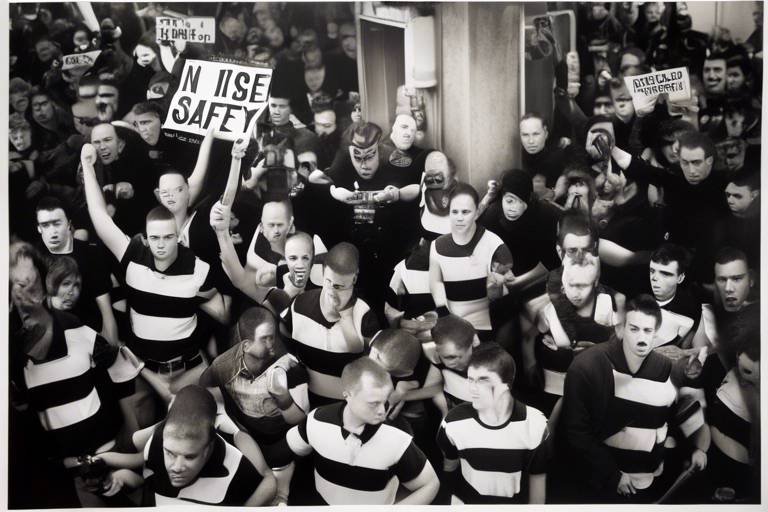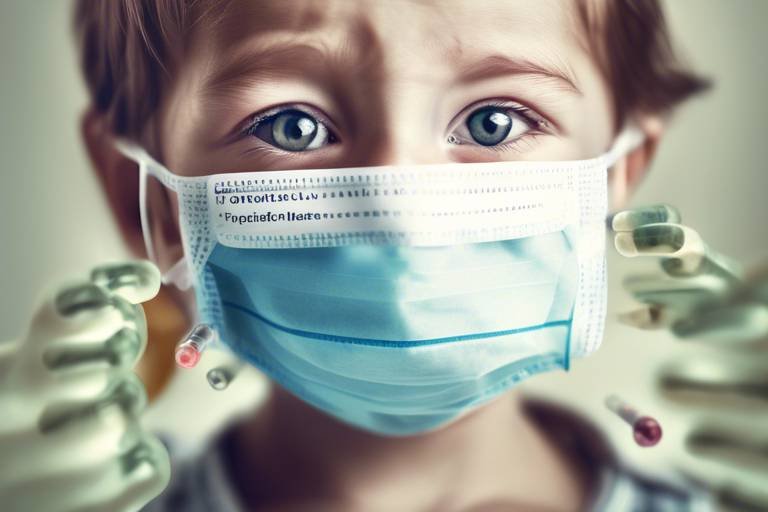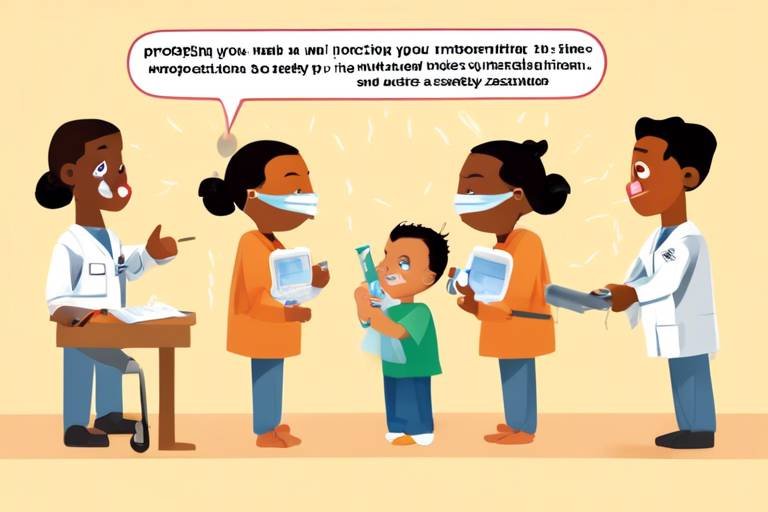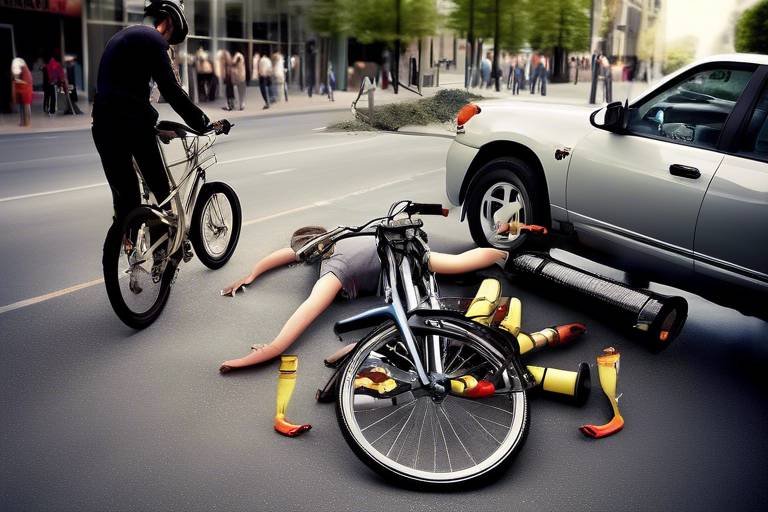Personal Safety: The Reasons for the Rise in Violent Crimes
In recent years, the world has witnessed a disturbing trend: the alarming increase in violent crimes. Whether it’s a shocking headline about a robbery gone wrong or a community shaken by a sudden surge in assaults, the reality is that many people are feeling less secure in their daily lives. This article aims to explore the various factors contributing to this unsettling rise, the societal implications, and most importantly, essential personal safety measures that individuals can adopt to protect themselves in today's environment.
Before diving into the root causes, it’s crucial to define what we mean by violent crimes. These offenses typically involve force or the threat of force against individuals. Common forms include homicide, assault, robbery, and sexual violence. According to recent statistics, violent crime rates have seen a significant uptick, with some areas reporting increases of up to 30% year-over-year. This surge isn’t just a number; it represents real people and communities affected by fear and trauma.
One of the most significant contributors to the rise in violent crimes is the socioeconomic landscape. Poverty, unemployment, and lack of education create a breeding ground for criminal behavior. When individuals struggle to meet their basic needs, desperation can lead to increasingly risky and violent actions. Research shows a direct correlation between low socioeconomic status and higher crime rates, indicating that communities facing economic hardships often experience more violence.
Another critical factor is the state of mental health in society. Untreated mental health conditions can lead to aggression and violence. When individuals do not receive the necessary support or treatment, their frustrations and emotional struggles can manifest in harmful ways. It's essential to recognize that mental health issues are not just personal struggles; they are societal challenges that require comprehensive solutions.
The accessibility of firearms also plays a significant role in the rise of violent crimes. In many regions, obtaining a weapon—whether legally or illegally—has become alarmingly easy. This accessibility increases the likelihood of violent encounters, as conflicts can escalate quickly when firearms are involved. The implications for personal safety are profound, making it crucial for individuals to be aware of their surroundings and the potential dangers they may face.
Moreover, substance abuse is a critical factor in many violent crimes. The relationship between drug and alcohol use and aggression is well-documented. When individuals are under the influence, their inhibitions lower, leading to impulsive and often violent behavior. Addressing substance abuse issues is vital not only for community safety but also for the well-being of those struggling with addiction.
In today’s digital age, the influence of social media cannot be overlooked. Platforms that once served as a means of connection have also become hotbeds for hate speech, cyberbullying, and the glorification of violence. The rapid spread of harmful ideologies can incite real-world violence, making it imperative for users to approach social media with caution and awareness.
As cities grow and populations swell, urbanization has a profound effect on crime rates. Higher population density often correlates with increased competition for resources, which can lead to heightened tensions and, ultimately, violence. Urban living conditions, such as overcrowding and poverty-stricken neighborhoods, further exacerbate these issues, contributing to a sense of insecurity among residents.
In response to these challenges, many communities are turning to community policing initiatives. These strategies foster collaboration between law enforcement and community members, aiming to build trust and reduce crime. By working together, communities can create safer environments and address the root causes of violence, promoting personal safety for all.
Finally, it’s essential for individuals to empower themselves with self-defense strategies. Knowing how to protect oneself can significantly enhance personal safety. Practical advice includes taking self-defense classes, being aware of one’s surroundings, and having a plan in case of an emergency. These measures not only build confidence but also equip individuals with the skills necessary to navigate potentially dangerous situations.
- What are the most common types of violent crimes? Homicide, assault, robbery, and sexual violence are among the most prevalent.
- How does socioeconomic status affect crime rates? Higher rates of poverty and unemployment often lead to increased crime as individuals struggle to meet their needs.
- What role does mental health play in violent crime? Untreated mental health issues can lead to increased aggression and violence.
- How can individuals protect themselves from violent crimes? Learning self-defense techniques, staying aware of surroundings, and utilizing community resources can enhance personal safety.

Understanding Violent Crimes
Violent crimes are a disturbing reality that many communities face today. They encompass a range of offenses that involve force or the threat of force against individuals. To put it simply, these crimes can be defined as acts that inflict harm or the potential for harm on another person. Some of the most common forms of violent crimes include homicide, assault, robbery, and sexual violence. Each of these categories carries its own implications and societal impacts, making it crucial for us to understand them better.
According to the latest statistics from the FBI, the rates of violent crimes have seen a significant uptick in recent years. For instance, in 2020 alone, there was a staggering increase of over 25% in murder rates across the United States. This spike is alarming, and it raises a plethora of questions about the underlying causes. What is driving this rise? Is it merely a reflection of societal issues, or are there deeper, systemic problems at play? To answer these questions, we need to delve into various contributing factors.
Understanding violent crimes also requires us to look at the demographics of those affected. For example, certain age groups, particularly young males, are disproportionately involved in violent crime, either as perpetrators or victims. This demographic trend highlights the need for targeted interventions and community programs aimed at reducing violence among youth. Moreover, the geographical aspect cannot be overlooked. Urban areas tend to report higher rates of violent crimes compared to rural settings, often due to factors like population density and socioeconomic disparities.
To illustrate the growing concern, consider the following table that summarizes the trends in violent crime rates over the past five years:
| Year | Murder Rate | Assault Rate | Robbery Rate |
|---|---|---|---|
| 2017 | 5.3 | 240.1 | 102.5 |
| 2018 | 5.0 | 235.0 | 98.3 |
| 2019 | 4.9 | 230.1 | 95.0 |
| 2020 | 6.9 | 270.0 | 110.0 |
| 2021 | 6.5 | 260.0 | 108.0 |
This table clearly indicates a troubling trend, particularly in the murder and assault rates, which have seen notable increases. The rise in violent crimes is not just a statistic; it translates into real-life fears and concerns for individuals and communities alike. It challenges the notion of safety and security that many of us take for granted.
As we navigate through this complex landscape, it becomes evident that understanding violent crimes is crucial for developing effective prevention strategies. By examining the various forms of these crimes and their underlying causes, we can begin to address the issues at their roots. It’s not just about reacting to violence; it's about preventing it before it happens. This understanding will pave the way for informed discussions about personal safety measures and community initiatives aimed at reducing the prevalence of violent crimes.

Socioeconomic Factors
When we talk about the rise in violent crimes, we can't ignore the impact of socioeconomic factors. It's like looking at a puzzle where each piece represents a different aspect of society, and when they don't fit together, chaos can ensue. Poverty, unemployment, and a lack of education are not just statistics; they are the real-life struggles that many individuals face daily. These challenges can lead to desperation, and desperation can often breed violence.
For instance, research has shown that communities with high unemployment rates tend to experience higher levels of crime. When individuals are unable to find work, they may feel hopeless and turn to illegal activities as a means of survival. This is not just a theory; it’s a pattern that has been observed in various studies across the globe. In fact, according to recent statistics, areas with unemployment rates exceeding 10% see a significant uptick in violent offenses compared to those with lower rates.
Moreover, education plays a crucial role in shaping an individual's future. Lack of access to quality education limits opportunities, reinforcing a cycle of poverty. When young people are not equipped with the skills needed to thrive in the workforce, they may resort to crime as a way to cope with their circumstances. The correlation between educational attainment and crime rates is evident—higher education levels generally lead to lower crime rates. Education is empowerment, and when people feel empowered, they are less likely to engage in violent behavior.
To illustrate this further, let’s take a look at a table that summarizes the relationship between socioeconomic factors and violent crime rates:
| Socioeconomic Factor | Impact on Violent Crime |
|---|---|
| Poverty | Increased desperation leading to higher crime rates |
| Unemployment | Higher likelihood of engaging in illegal activities |
| Lack of Education | Limited opportunities resulting in criminal behavior |
In addition to these factors, we must also consider the role of community resources. Areas that lack access to social services, mental health support, and recreational activities often see higher crime rates. When communities are deprived of these essential resources, they can become breeding grounds for crime. It’s like a garden without water; without the right support, it can’t flourish, leading to a decline in overall safety and stability.
It's important to recognize that addressing these socioeconomic factors is not just a matter of law enforcement; it requires a comprehensive approach that includes community engagement, education reforms, and economic development initiatives. By investing in communities and providing individuals with the tools they need to succeed, we can begin to dismantle the cycle of violence that plagues many areas today.
In conclusion, the socioeconomic factors contributing to violent crimes are complex and intertwined. Understanding this relationship is crucial for developing effective strategies to combat crime and enhance personal safety. It's not just about punishing offenders; it's about creating an environment where individuals have the opportunity to thrive, reducing the likelihood of crime in the first place.

The Role of Mental Health
Mental health plays a crucial role in the dynamics of violent crime. When we think about violence, it's easy to jump to conclusions or stereotypes, but the reality is far more complex. Untreated mental health conditions can lead to increased aggression, impulsivity, and a lack of empathy, all of which can escalate into violent behavior. Imagine driving a car without brakes; it’s only a matter of time before an accident occurs. Similarly, individuals grappling with mental health issues may find themselves unable to control their impulses, leading to tragic outcomes.
Statistics reveal a disturbing correlation between mental health disorders and violent crime. According to various studies, individuals with untreated mental illnesses are more likely to engage in violent acts, particularly when combined with substance abuse. This connection is not just a statistic; it’s a reality that affects families, communities, and public safety. For instance, a recent report indicated that nearly 25% of violent crimes were committed by individuals suffering from severe mental health issues. This is not to say that everyone with mental health challenges is violent, but the risks are significantly heightened without proper treatment and support.
Moreover, the stigma surrounding mental health often prevents individuals from seeking the help they need. Many people fear judgment or discrimination, which can lead to a downward spiral of worsening conditions. It’s crucial to foster an environment where mental health is openly discussed and treated with the same seriousness as physical health. Community programs aimed at raising awareness about mental health can create a ripple effect, encouraging individuals to seek help and reducing the stigma associated with mental health issues.
Addressing mental health is not just a personal responsibility; it’s a societal one. Implementing comprehensive mental health services, including counseling and rehabilitation, can significantly reduce the likelihood of violence. Communities can benefit from integrating mental health education into schools and workplaces, ensuring that individuals understand the signs of mental distress and know where to seek help. The goal should be to create a supportive network that prioritizes mental well-being, which in turn can lead to safer environments for everyone.
In conclusion, the role of mental health in the rise of violent crimes cannot be overstated. By prioritizing mental health treatment and education, we can not only help those in need but also enhance the safety and well-being of our communities. It’s a collective effort that requires awareness, understanding, and action from all of us.

Access to Firearms
When we talk about violent crimes, one of the most pressing issues is the . It's almost like opening a Pandora's box; once you unleash the potential for violence, it can be incredibly challenging to rein it back in. In many parts of the world, guns are readily available, and this accessibility can lead to devastating consequences. According to the Gun Violence Archive, there were over 43,000 gun-related deaths in the United States alone in 2020, a staggering number that highlights the urgent need to address this issue.
The implications of firearm access extend beyond just statistics. Imagine a community where firearms are as common as smartphones. In such environments, conflicts can escalate rapidly, often resulting in tragic outcomes. The ease of obtaining a gun, whether legally or illegally, can create a culture where violence is seen as a viable solution to disputes. This is particularly concerning when you consider how many violent crimes are committed with firearms. In fact, studies suggest that about 60% of homicides in the U.S. involve a firearm. This correlation raises a crucial question: how can we balance the right to bear arms with the need for public safety?
Furthermore, the methods through which individuals acquire firearms can vary significantly. Legal avenues, such as gun shops and private sales, often come with regulations; however, these laws can differ dramatically from one state to another. For instance, some states have stringent background checks, while others have very few restrictions. On the other hand, illegal means of obtaining firearms, such as through the black market, can bypass these regulations entirely, making it alarmingly easy for individuals with violent intentions to access weapons.
To illustrate the disparities in firearm access across different regions, consider the following table:
| Region | Legal Restrictions | Gun Ownership Rate | Gun-Related Homicides |
|---|---|---|---|
| United States | Varies by state | 120.5 per 100 people | 4.12 per 100,000 |
| Canada | Strict | 34.7 per 100 people | 0.5 per 100,000 |
| Australia | Very strict | 15.0 per 100 people | 0.13 per 100,000 |
This table clearly shows how regions with stricter gun laws tend to have lower rates of gun ownership and, correspondingly, fewer gun-related homicides. It's a compelling argument for reevaluating our approach to firearm regulations. The conversation should not only focus on the rights of individuals to own firearms but also on the societal implications of widespread gun access.
In conclusion, the access to firearms is a multifaceted issue that intertwines with personal safety and societal violence. As we navigate this complex landscape, it is essential to engage in open discussions about how to create a safer environment for everyone. After all, it’s not just about the guns; it’s about the lives they impact.

Substance Abuse
Substance abuse is a significant factor that cannot be ignored when discussing the rise in violent crimes. The relationship between drug and alcohol use and aggression is well-documented, and it paints a troubling picture of how substances can alter behavior and lead to violent actions. When individuals engage in substance abuse, they often experience a range of psychological and physical effects that can impair their judgment and escalate conflicts. Imagine a person under the influence of alcohol, whose inhibitions are lowered, making them more prone to aggressive outbursts. It’s like throwing gasoline on a fire; the potential for violence increases dramatically.
According to various studies, individuals who abuse substances are more likely to engage in violent behavior. Here’s a quick overview of the types of substances commonly linked to violence:
| Substance | Effects on Behavior |
|---|---|
| Alcohol | Increased aggression, impaired judgment |
| Cocaine | Heightened energy, paranoia, impulsivity |
| Opioids | Withdrawal symptoms can lead to desperation and violence |
| Stimulants | Increased agitation, risk-taking behaviors |
Furthermore, the social environment plays a crucial role in substance abuse and its connection to violence. In areas where drugs are readily available, the likelihood of violent crime tends to increase. This is often exacerbated by factors such as poverty and lack of education, creating a vicious cycle where individuals turn to substance abuse as an escape, which in turn leads to more violent behavior.
It's also essential to consider the context of substance abuse. For instance, in many cases, individuals may commit violent acts while under the influence of drugs or alcohol, but the root causes often lie deeper. Issues such as trauma, mental health disorders, and a lack of support systems can all contribute to the cycle of violence associated with substance abuse. Addressing these underlying issues is vital for any effective intervention.
In summary, substance abuse is not just a personal issue; it’s a societal problem that fuels the fire of violence in our communities. Understanding this connection is crucial for developing effective strategies to combat violent crimes. By tackling substance abuse head-on, we can make strides toward reducing violence and improving personal safety for everyone.

Social Media Influence
In today's digital age, social media has become an integral part of our lives, shaping our thoughts, behaviors, and even our perceptions of reality. While it offers numerous benefits, such as connectivity and information sharing, it also harbors darker implications, especially concerning violent crime. Have you ever noticed how quickly a viral trend can escalate into something dangerous? Social media platforms can act as catalysts for violence, often amplifying negative sentiments and behaviors.
One of the most concerning aspects of social media is its role in the spread of hate speech and cyberbullying. These toxic behaviors can lead to real-world violence, as individuals who feel threatened or marginalized may retaliate. For instance, online harassment can escalate into physical confrontations, creating a vicious cycle of violence. Moreover, the anonymity that social media provides can embolden individuals to express aggressive thoughts they might otherwise suppress in face-to-face interactions.
Furthermore, the glorification of violence in various forms of content, such as videos, memes, and even music, can desensitize users to aggression. When young people are exposed to violent imagery repeatedly, they may begin to view such behaviors as acceptable or even admirable. This normalization of violence is alarming and can lead to an increase in aggressive actions among impressionable audiences. A study by the American Psychological Association found that children exposed to violent media are more likely to exhibit aggressive behavior.
| Type of Content | Impact on Behavior |
|---|---|
| Violent Video Games | Increased aggression and desensitization to violence |
| Hate Speech | Encourages real-world violence and hostility |
| Cyberbullying | Leads to emotional distress and potential retaliation |
In addition to these issues, social media can also facilitate the organization of violent groups or movements. Platforms like Facebook and Twitter have been used to rally individuals around extremist ideologies, leading to increased recruitment for violent organizations. This digital recruitment can be particularly dangerous, as it allows for the rapid spread of radical ideas and the mobilization of individuals who might not have otherwise engaged in violent acts.
So, what can be done to mitigate the influence of social media on violent crime? First and foremost, it’s essential for users to critically evaluate the content they consume and share. Engaging in conversations about the impact of online behavior can help raise awareness and promote a culture of empathy and understanding. Additionally, social media companies must take responsibility for monitoring and addressing harmful content, implementing stricter policies against hate speech and violent imagery.
Ultimately, while social media can be a powerful tool for positive change, it can also serve as a breeding ground for violence if left unchecked. By fostering a more informed and responsible online community, we can work towards reducing the negative impacts of social media on personal safety and society as a whole.

Urbanization and Crime Rates
Urbanization has become a defining characteristic of modern society, transforming the way we live, work, and interact with one another. As cities expand and populations swell, we often see a corresponding rise in crime rates, particularly violent crimes. But why does this happen? One might think that with more people comes more safety in numbers; however, the reality is often quite the opposite. High population density can lead to increased competition for resources, social tensions, and, unfortunately, a greater likelihood of criminal behavior.
Research indicates that urban areas tend to experience higher crime rates than rural regions. This can be attributed to several factors that are unique to city living. For instance, the anonymity of urban life can embolden individuals to commit crimes they might not otherwise consider in smaller, close-knit communities. In bustling cities, people are often less likely to know their neighbors, which can create a sense of isolation and disconnect. This detachment can lead to an increase in criminal activities, as individuals feel less accountable for their actions.
Moreover, urban environments often grapple with issues like poverty and unemployment, which can further exacerbate crime rates. As more people flock to cities in search of better opportunities, the strain on resources can lead to economic disparities. A significant portion of the urban population may find themselves living in impoverished conditions, which can breed frustration and desperation, leading to increased criminal activities. The correlation between socioeconomic status and crime is well-documented, and urban areas frequently exhibit stark contrasts in wealth distribution.
To illustrate the impact of urbanization on crime rates, consider the following table that summarizes crime statistics from various urban and rural areas:
| Area Type | Average Violent Crimes per 1,000 Residents |
|---|---|
| Urban Areas | 8.5 |
| Rural Areas | 2.1 |
As we can see from the table, urban areas experience a significantly higher rate of violent crimes compared to their rural counterparts. This stark contrast raises important questions about how we can enhance personal safety in densely populated environments. Community initiatives, better policing strategies, and social programs aimed at addressing the root causes of crime are essential in mitigating these issues.
Additionally, urbanization often leads to the breakdown of community structures. In smaller towns, people tend to have stronger social ties and a shared sense of responsibility for one another. However, as cities grow, these bonds can weaken, leading to a lack of communal oversight. The absence of a watchful community can make it easier for crime to flourish, as individuals may feel less inclined to intervene or report suspicious activities.
So, what can be done to combat this rise in crime associated with urbanization? It begins with fostering a sense of community. Initiatives that encourage neighborly connections, such as community watch programs or local events, can help rebuild trust among residents. Furthermore, cities can invest in social services and educational programs that provide support to those in need, ultimately addressing some of the root causes of crime.
In conclusion, while urbanization brings about many benefits, it also poses significant challenges regarding crime rates. Understanding the complex relationship between urban living and criminal behavior is crucial for developing effective strategies to enhance personal safety and foster a thriving urban environment.
- What is the primary reason for increased crime rates in urban areas?
Urban areas often experience higher crime rates due to factors such as population density, socioeconomic disparities, and weakened community ties. - How can communities reduce crime rates?
Communities can reduce crime rates by fostering social connections, implementing community watch programs, and investing in educational and social services. - Are rural areas safer than urban areas?
Generally, rural areas have lower crime rates compared to urban areas, largely due to stronger community ties and lower population density.

Community Policing Initiatives
Community policing initiatives have emerged as a powerful strategy in the fight against violent crime, focusing on building strong relationships between law enforcement and the communities they serve. This approach shifts the traditional paradigm of policing from a purely reactive model to a more proactive engagement with citizens. Imagine a neighborhood where police officers are not just figures of authority but also trusted allies, working hand in hand with residents to create a safer environment. This transformation is not just a dream; it’s becoming a reality in many areas across the country.
At the heart of community policing is the idea that **collaboration** is key. Police officers are encouraged to engage with community members through various programs and activities. These initiatives often include neighborhood watch programs, community forums, and youth outreach activities. By fostering open lines of communication, officers can better understand the unique challenges faced by different neighborhoods. For instance, in areas plagued by gang violence, police may work closely with local organizations to provide support and resources aimed at preventing youth from joining gangs.
One effective example of community policing is the implementation of **community advisory boards**. These boards consist of local residents who meet regularly with police representatives to discuss crime trends, safety concerns, and community needs. This initiative not only empowers residents but also gives law enforcement valuable insights into the specific issues affecting their neighborhoods. By involving the community in decision-making processes, trust is built, and cooperation flourishes. As a result, many communities have reported a noticeable decrease in crime rates and an increase in public satisfaction with police services.
Moreover, community policing initiatives often emphasize **crime prevention** rather than just crime response. Officers may host workshops on personal safety, self-defense, and conflict resolution, which equip residents with the skills they need to protect themselves and their property. For example, a neighborhood might organize a series of self-defense classes led by local law enforcement, which not only teaches valuable skills but also strengthens the bond between officers and residents. This proactive approach can deter crime before it happens, creating a sense of security among community members.
However, the success of community policing initiatives depends largely on **community involvement**. It’s essential for residents to be active participants in these programs. When individuals feel invested in their community, they are more likely to report suspicious activities, attend meetings, and collaborate with law enforcement. This partnership not only enhances public safety but also fosters a sense of ownership and pride in the community. In this way, community policing can be likened to a garden; it requires the nurturing of relationships and the cultivation of trust to thrive.
In summary, community policing initiatives represent a **holistic approach** to combating violent crime. By prioritizing relationships, prevention, and community engagement, these programs not only help reduce crime rates but also empower citizens. As neighborhoods become more united and proactive, the overall safety and quality of life improve, creating an environment where everyone can thrive.
- What is community policing? Community policing is a strategy that focuses on building positive relationships between law enforcement and community members to enhance public safety.
- How can I get involved in community policing initiatives? You can participate by attending community meetings, joining neighborhood watch programs, or volunteering for local outreach activities.
- What are the benefits of community policing? Benefits include reduced crime rates, improved community trust in law enforcement, and increased public engagement in safety initiatives.
- Are community policing initiatives effective? Yes, many studies have shown that community policing strategies can lead to significant reductions in crime and improvements in community relations.

Self-Defense Strategies
In a world where personal safety is becoming increasingly paramount, understanding can be a game-changer. It’s not just about learning to throw a punch or kick; it’s about equipping yourself with the knowledge and skills to protect yourself in various situations. Think of self-defense as your personal safety toolkit, where each technique is a tool ready to be used when needed. But what exactly should you include in your toolkit?
First and foremost, awareness is your best defense. Being aware of your surroundings can help you avoid potential threats before they escalate. Imagine walking through a park; instead of being glued to your phone, take a moment to observe the people around you. Are there any suspicious behaviors? Are you in a well-lit area? This proactive approach can significantly reduce your risk of encountering violence.
Next, consider taking self-defense classes. These classes not only teach you physical techniques but also boost your confidence. You’ll learn how to react in high-pressure situations, which can make a world of difference. Many local community centers and gyms offer classes tailored for beginners, so don’t hesitate to look for one near you. Additionally, practicing these techniques regularly helps reinforce your skills. Just like any other skill, the more you practice, the better you become.
Another important aspect of self-defense is understanding the legal implications of using force. It’s essential to know the laws in your area regarding self-defense. For instance, in some jurisdictions, you are allowed to use reasonable force to protect yourself, while in others, the laws can be more stringent. Familiarizing yourself with these laws can help you make informed decisions in critical moments.
Moreover, carrying self-defense tools can provide an added layer of security. Items like pepper spray, personal alarms, or even a tactical flashlight can be effective in deterring an attacker. However, it’s crucial to know how to use these tools properly. Just having them in your bag won’t help if you don’t know how to deploy them effectively.
Lastly, consider forming a safety network with friends or family. This network can provide emotional support and practical assistance. If you’re going out alone at night, let someone know your plans and check in with them afterward. It’s like having a safety net; knowing that someone is looking out for you can be incredibly reassuring.
In summary, self-defense strategies encompass a wide range of techniques and approaches. From being aware of your surroundings to understanding legal implications and forming a support network, every step you take towards enhancing your personal safety is a step in the right direction. Remember, the goal is not just to fight back but to avoid confrontation whenever possible. After all, the best self-defense strategy is one that keeps you safe without needing to engage in violence.
- What should I do if I feel threatened? Trust your instincts and remove yourself from the situation if possible. Seek help from authorities if needed.
- Are self-defense classes worth it? Absolutely! They provide practical skills and boost your confidence in handling potential threats.
- What self-defense tools are recommended for beginners? Pepper spray, personal alarms, and tactical flashlights are great options for beginners.
- Is it legal to use self-defense? Yes, but laws vary by location. It’s essential to understand your local laws regarding self-defense.
Frequently Asked Questions
- What are violent crimes?
Violent crimes are offenses that involve the use or threat of force against individuals. This includes actions like assault, robbery, homicide, and sexual violence. Understanding these crimes is crucial as they have been on the rise, impacting communities and personal safety.
- What factors contribute to the rise in violent crimes?
The rise in violent crimes can be attributed to several factors, including socioeconomic issues like poverty and unemployment, mental health challenges, substance abuse, and the accessibility of firearms. Each of these elements plays a significant role in shaping the environment where violent crimes can occur.
- How does mental health affect violent crime rates?
Mental health issues can lead to increased aggression and violence, particularly when left untreated. Individuals struggling with mental health conditions may lack the coping mechanisms to handle stress or anger, resulting in violent behavior. Addressing these mental health challenges is essential for reducing crime rates.
- What is the impact of social media on violent crime?
Social media can exacerbate violent crime by spreading hate speech and cyberbullying, which can incite real-world violence. Additionally, the glorification of violent acts in media can desensitize individuals and normalize aggressive behavior, further contributing to the problem.
- How does urbanization relate to crime rates?
Urbanization often leads to higher population density, which can strain resources and contribute to increased crime rates. The challenges associated with urban living, such as poverty and lack of community cohesion, can create an environment where violent crimes are more likely to occur.
- What are some effective self-defense strategies?
Self-defense strategies include being aware of your surroundings, learning basic self-defense techniques, and having a personal safety plan. It's also helpful to carry safety devices, like pepper spray or personal alarms, to deter potential attackers and enhance your personal safety.
- How can community policing initiatives help reduce violent crimes?
Community policing initiatives foster collaboration between law enforcement and community members. By building trust and encouraging open communication, these programs can lead to more effective crime prevention strategies, making neighborhoods safer and reducing the incidence of violent crimes.



















